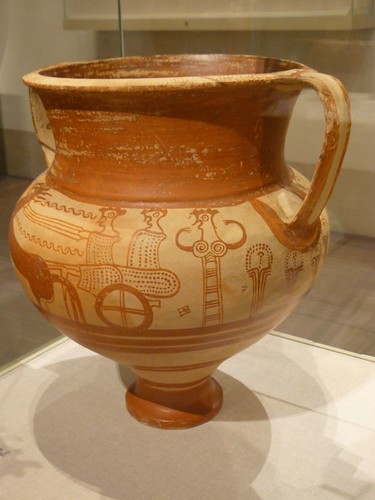I learned a great deal about Ancient art in this class. I truly enjoyed learning about how people made art thousands years ago. More specifically, I found most enjoy when studying Egyptian art and Greek art.
Egyptian art is quite interesting from the composite view to the Great Pyramids. I found the composite view enthralling, mostly because the Egyptians used this technique for such a long time. Composite view is the use of multiple views incorporated into one, such as the head in profile with a front facing eye. Not only that the Egyptians used the technique but many other cultures took on the technique too, for instance Minoan art utilizes the composite view. The canon of proportion was also used for a very long time in Egyptian art. The canon of proportions is achieved by drawing a grid first and conforming figures to the grid, that way all figures portrayed are the similar looking. The Judgment of Hunefer before Osiris is an example of both the composite view and the canon of proportions. All figures portrayed are in composite view, their heads in profile with front facing eye, frontal chest and the legs are viewed from the side. Overall composite view is not a very naturalist but this technique conveys important features in a way that best describes them. Although most people have a general history of the Great Pyramids, in this class I learned that these enormous structures can be seen as art. The Great Pyramids were built for the Kings Menkaura, Khafra and Khufu. The pyramids serve as tombs for these kings. When learning about these structures I did not know that once the structures were built they then had a thick polished limestone veneer which has eroded since then. I think part of the reason I find the Great Pyramids so interesting because of their size and that they were able to build something of that size without machinery.
I also enjoyed learning about Greek art. Most everyone has seen some sort of Greek art, stark white marble sculptures, little do they know that at one point these sculptures were painted. After learning that Greek artists painted their sculptures I have a completely different view of their art. Painted or not Greek sculptures are quite beautiful. Peplos Kore is a sculpture of a woman, if she is seen without paint you can see details of her long hair and face. If you view the same statue with paint, she comes alive, which is the reason Greek artist painted their work. Greek artists felt that their statues are more naturalistic when painted. The Archer, from the west pediment of the Temple Of Aphaia
Egyptian art uses techniques, like the composite view and the canon of proportions, to refine their art for generations to come. Greek art transforms with paint to become lively and more naturalistic. After everything I learned this quarter, I can not wait to learn about more art history.






